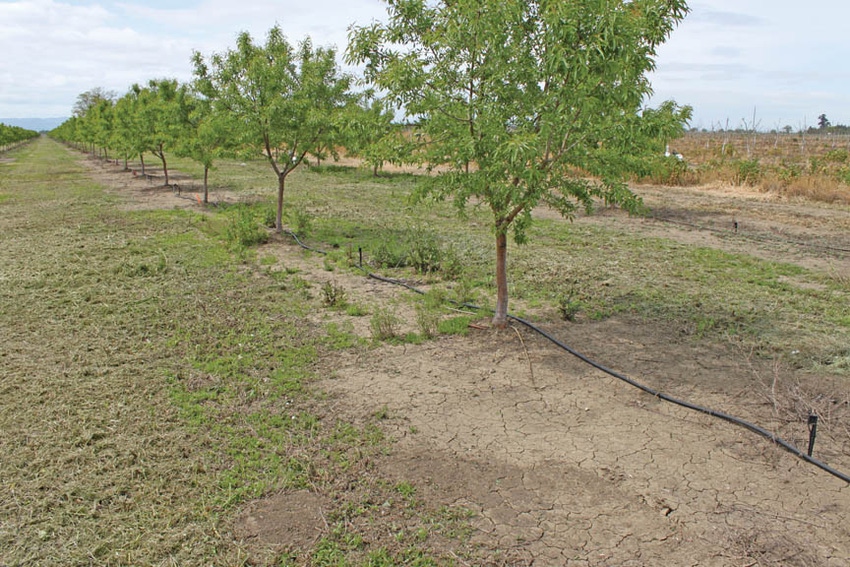October 17, 2018

Herbicide-resistant weed populations continue to emerge due to the repeated use of certain herbicide chemistries. As the list of weeds that are resistant to those chemicals expands, this national issue continues to grow.
To combat herbicide resistance, it is critical that almond growers implement integrated weed management strategies.
Over the last two years, the Weed Science Society of America, with funding from the USDA, held listening sessions across the country to better understand weed control issues for growers and what their expectations are. The following summarizes the growers’ response (Schroeder et al., 2018. Managing Wicked Herbicide-Resistance: Lessons from the Field. Weed Technol 32:475–488. doi: 10.1017/wet.2018.49 ):
■ We want new herbicides, especially those with new mechanisms of action.
■ We believe there is no need for more government regulation of herbicides.
■ Diverse integrated weed management options are necessary for herbicide resistance management (HRM), but achieving such diversity in weed management and cropping systems is difficult, at best.
While growers assume new chemistries will be available to deal with herbicide resistance, the EPA has publicly stated that it has not received an application to register a fundamentally new type of herbicide chemistry in over 30 years.
AN ONGOING CONCERN
In a recent conversation about the importance of integrated weed management for almond growers, Brad Hanson, UC Cooperative Extension weed science specialist, emphasized the need for growers to tailor strategies to fit their land and specific weed mixes.
There are many day-to-day decisions that must be made, especially as, according to Hanson, ��“in most cases, once resistance occurs the population is unlikely to revert to susceptible.” Essentially, once you have a resistant population, solutions can be both difficult and expensive.
There are three main categories of almond orchard weeds with documented resistance to herbicides:
Annual broadleaf: The two related species, hairy fleabane and horseweed, are both common annual weeds that have been a problem for the past 12 years due to glyphosate-resistance. Both species also have some populations that are resistant to paraquat.
Winter annual grasses: The ryegrass group is a major part of the weed management problem in the Sacramento Valley and pockets of the San Joaquin Valley, where glyphosate-resistance has been documented for nearly 15 years. There are also ryegrass populations with varying levels of resistance to other herbicides, including glufosinate, paraquat, and grass-specific herbicides like fluazifop. More recently, populations of annual bluegrass have been identified with resistance to glyphosate and paraquat, as well.
Summer annual grasses: Glyphosate-resistant populations of jungle-
rice have been identified throughout the Central Valley, and similar challenges have been reported with other summer-emerging grasses, including threespike goosegrass, feather fingergrass, and witchgrass.
INTEGRATED MANAGEMENT PRACTICES
By diversifying the weed management tools applied, growers and their PCAs can help slow the rate of herbicide resistance development and spread. When reviewing current weed management choices, solutions for weed management may differ in the tree row versus the middles, by soil types, and by irrigation systems.
Here are some integrated weed management tools growers and their PCAs should consider to reduce the potential for herbicide resistant weeds (for more information visit the UC-IPM website):
■ Regularly scout the orchard, and properly identify the kinds of weeds that are present, as the efficacy of different herbicides varies with different plant species. Also, track weeds and their locations to identify changes in populations earlier.
■ To reduce the seedbank, ensure that timing of weed treatments occurs before seed set of key weeds. Mowing right before harvest means most weeds will have set seed; harvest activities will spread those seeds around.
■ Consider mowing or tillage/cultivation within the middles to reduce some herbicide use.
■ Consider the use of spot treatment or hand crews for tree rows, especially if you have localized sites of herbicide-resistant or difficult-to-control weeds.
■ Incorporate herbicides with different modes of action in both pre- and post-emergent herbicide sprays to combat particularly troublesome weeds. The UC-IPM website provides a table of currently registered herbicides available to almonds, and which weeds they control.
LONG-TERM BENEFITS
There are approximately two dozen herbicides registered for use in almonds, but they vary in cost and efficacy. To improve integrated weed management practices, Hanson has been looking into several sequential herbicide programs that aim to address winter weeds with a winter application, and summer-emerging weeds with a late-spring application.
Rather than applying high rates of residual herbicides all at once in the winter to control both winter and summer weeds, the idea is to use available tools at times that separately target the early- and later-emerging weeds. Ultimately, the idea is to get better season-long control with no additional — and ideally, less — herbicide, benefiting both the environment and the economic bottom line.
Remember: More herbicide is not necessarily the answer for better weed control, Hanson says. Consider carefully the weeds to be controlled, evaluate the tools available and use the tools at the most appropriate times. Using an appropriate herbicide and rate at the right time of year will nearly always be more effective and safer than using a very high rate of a potentially very effective herbicide mixture at the wrong time of year.
A well-considered and implemented weed management plan makes economic and stewardship sense.
About the Author(s)
You May Also Like




